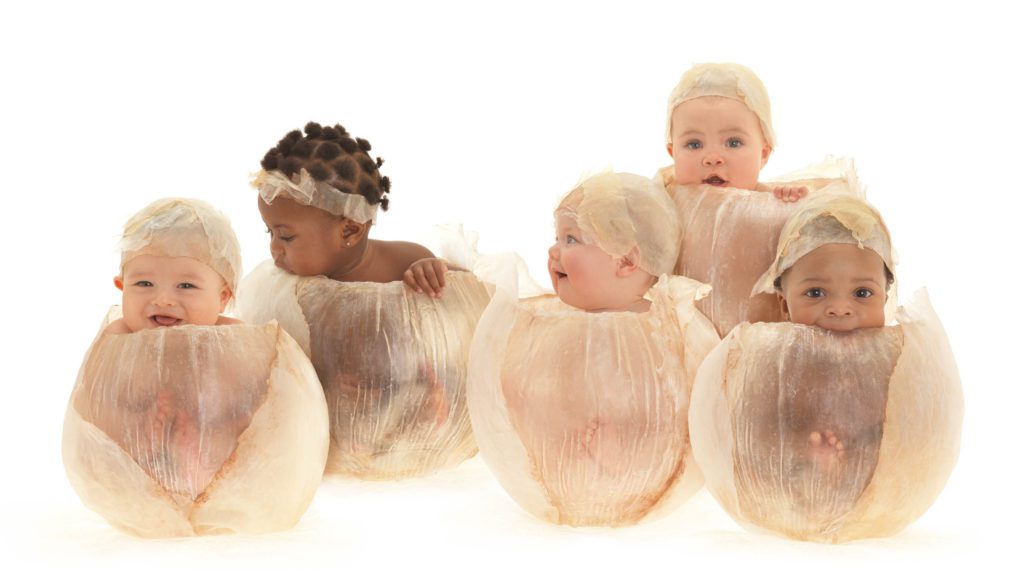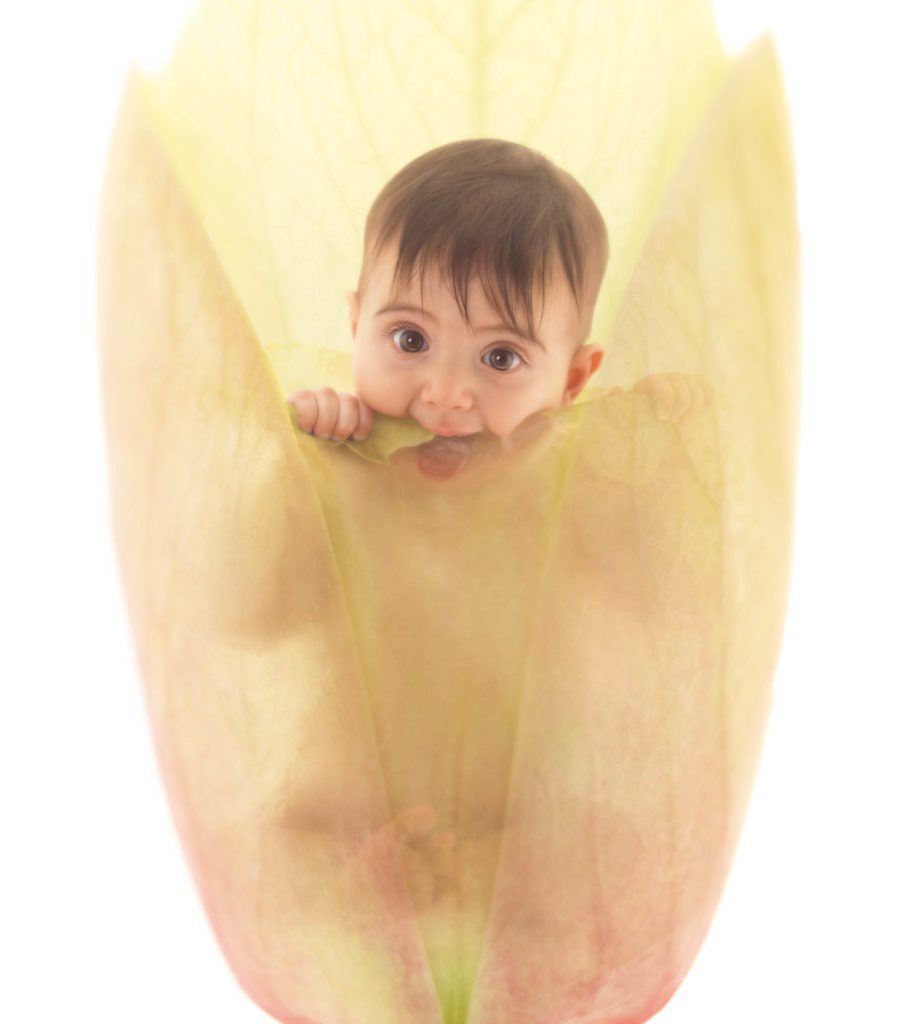When, What, and How to Introduce Solid Foods
Did You Know?

The Dietary Guidelines for Americans and the American Academy of Pediatrics recommend children be introduced to foods other than breast milk or infant formula when they are about 6 months old. Introducing foods before 4 months old is not recommended. Every child is different. How do you know if your child is ready for foods other than breast milk or infant formula? You can look for these signs that your child is developmentally ready.
Your child:
- Sits up alone or with support.
- Is able to control head and neck.
- Opens the mouth when food is offered.
- Swallows food rather than pushes it back out onto the chin.
- Brings objects to the mouth.
- Tries to grasp small objects, such as toys or food.
- Transfers food from the front to the back of the tongue to swallow.
What Foods Should I Introduce to My Child First?
The American Academy of Pediatrics says that for most children, you do not need to give foods in a certain order. Your child can begin eating solid foods at about 6 months old. By the time he or she is 7 or 8 months old, your child can eat a variety of foods from different food groups. These foods include infant cereals, meat or other proteins, fruits, vegetables, grains, yogurts and cheeses, and more.
If your child is eating infant cereals, it is important to offer a variety of infant cereals such as oat, barley, and multi-grain instead of only rice cereal. Only providing infant rice cereal is not recommended by the Food and Drug Administration because there is a risk for children to be exposed to arsenic. Visit the U.S. Food & Drug Administration to learn more.
How Should I Introduce My Child to Foods?
Did You Know?
Your child needs certain vitamins and minerals to grow healthy and strong.
Now that your child is starting to eat food, be sure to choose foods that give your child all the vitamins and minerals they need.
Click here to learn more about some of these vitamins & minerals.
Let your child try one single-ingredient food at a time at first. This helps you see if your child has any problems with that food, such as food allergies. Wait 3 to 5 days between each new food. Before you know it, your child will be on his or her way to eating and enjoying lots of new foods.
Introduce potentially allergenic foods when other foods are introduced.
Potentially allergenic foods include cow’s milk products, eggs, fish, shellfish, tree nuts, peanuts, wheat, soy, and sesame. Drinking cow’s milk or fortified soy beverages is not recommended until your child is older than 12 months, but other cow’s milk products, such as yogurt, can be introduced before 12 months. If your child has severe eczema and/or egg allergy, talk with your child’s doctor or nurse about when and how to safely introduce foods with peanuts.
How Should I Prepare Food for My Child to Eat?
At first, it’s easier for your child to eat foods that are mashed, pureed, or strained and very smooth in texture. It can take time for your child to adjust to new food textures. Your child might cough, gag, or spit up. As your baby’s oral skills develop, thicker and lumpier foods can be introduced.
Some foods are potential choking hazards, so it is important to feed your child foods that are the right texture for his or her development. To help prevent choking, prepare foods that can be easily dissolved with saliva and do not require chewing. Feed small portions and encourage your baby to eat slowly. Always watch your child while he or she is eating.
Here are some tips for preparing foods:
- Mix cereals and mashed cooked grains with breast milk, formula, or water to make it smooth and easy for your baby to swallow.
- Mash or puree vegetables, fruits and other foods until they are smooth.
- Hard fruits and vegetables, like apples and carrots, usually need to be cooked so they can be easily mashed or pureed.
- Cook food until it is soft enough to easily mash with a fork.
- Remove all fat, skin, and bones from poultry, meat, and fish, before cooking.
- Remove seeds and hard pits from fruit, and then cut the fruit into small pieces.
- Cut soft food into small pieces or thin slices.
- Cut cylindrical foods like hot dogs, sausage and string cheese into short thin strips instead of round pieces that could get stuck in *the airway.
- Cut small spherical foods like grapes, cherries, berries and tomatoes into small pieces.
- Cook and finely grind or mash whole-grain kernels of wheat, barley, rice, and other grains.*
https://www.cdc.gov/nutrition/InfantandToddlerNutrition/resources.html#videos
These Puree’s are great starters
Broccoli – Broccoli greens are a nutritional powerhouse. They contain a number of vitamins and minerals that babies need, including vitamins A, C, K, B6, and folate, and it even contains every other mineral including calcium, iron and zinc, all of which are crucial for optimal growth and development.
Broccoli has a number of cousins that are also wonderful for babies: Romanesco (a gorgeous lime-green Italian variety); Purple Sprouting Broccoli, which is common in England; and Broccoli Rabe, a more bitter variety. All are wonderfully nutritious for babies! Fun fact: broccoli is actually an edible flower!
Spinach – Spinach is one of the most popular vegetables across the globe, mainly because of its health benefits, not only for grown-ups but also for kids and babies. Spinach serves as a high source of essential minerals and vitamins that make the body strong internally by improving organ functionalities.
Apart from essential minerals, Spinach also provides a good amount of vitamins to your baby’s body. These include Vitamin A, Vitamin C, Vitamin E, Vitamin K, thiamin, folate etc. All these vitamins together improve immunity and maintain a strong and healthy body
With ample amounts of dietary fiber, this leafy vegetable is often used as a natural laxative and helps in keeping the digestive system on track. This can be a blessing for babies who often get constipated. Spinach absorbs water and adds bulk to the stool, helping in an easy bowel movement that can do wonders for a constipated baby who will just not know what to do other than cry all day!
Carrots – Carrots are naturally sweet and mellow, just right for a baby’s simple palate. What’s more, they’re packed with essential nutrients and are easy to use as a baby food ingredient.
Carrots are very high in vitamin A, which is needed to support the immune system, as well as your heart, lungs, and kidneys. It also supports eye health, specifically the retina, eye membrane, and cornea. Babies under six months need 400 mcg of vitamin A per day, and babies between six months and a year old need 500 mcg per day.
Carrots are also a good source of other vitamins, like vitamin K, which helps blood clot properly, and vitamin B6, which is necessary for skin, hair, eye, and liver health.
They’re a good source of fiber, which your baby might need more of if you’re feeding them a lot of low-fiber foods like baby cereals.
Introducing Brillant Baby Foods – The Purest Baby Food
Brilliant Baby Food grows its own produce without pesticide, herbicide, GMOs, or animal or human contaminants. And most importantly, the water and elements we use to grow our products are tested by an independent laboratory before being fed to our seeds and sprouts AND after being made into baby food. Double Testing ensures only the best!
Natural
Brilliant Baby Food is made from crops grown from heirloom seeds. No pesticides, no herbicides, no GMO’s, no additives.
Fresh
Made from the purest produce–harvested the same day–Brilliant Baby Food has the highest nutritional value.
100% Healthy
Our baby food sets a new standard far exceeding FDA, EPA, and USDA safety guidelines for arsenic, lead, mercury, etc.
